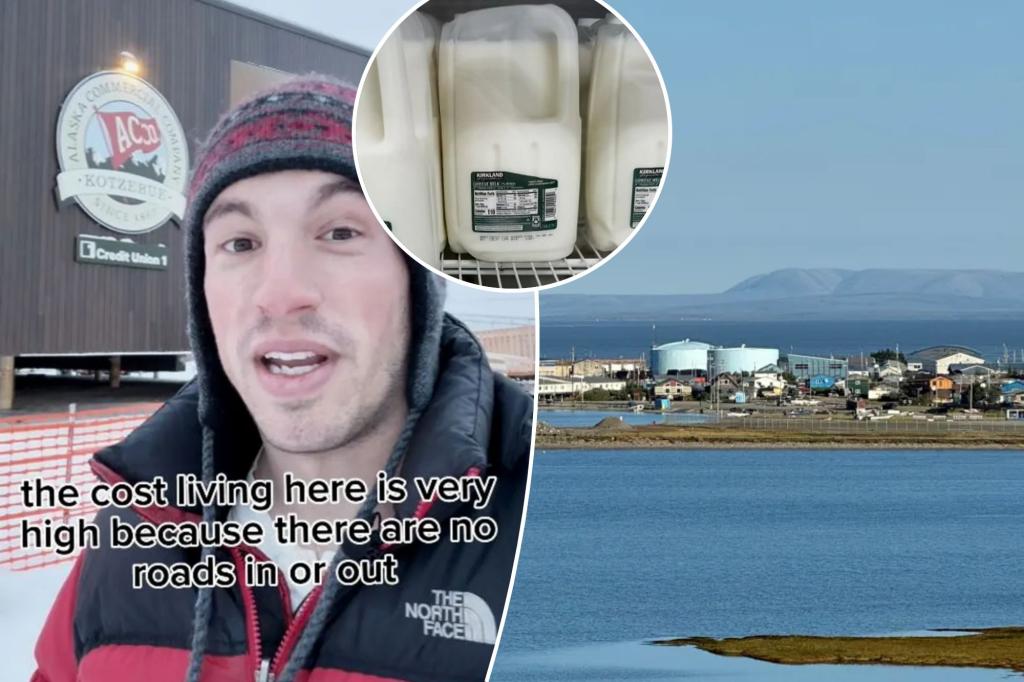The remote Alaskan town of Kotzebue, nestled in the Northwest Arctic Borough, faces a stark reality: the exorbitant cost of everyday groceries. Located over 500 miles from Alaska’s largest city, Anchorage, and accessible only by air, Kotzebue’s isolation translates into a significant price hike for essential goods. Recent videos shared on social media by Grant Magdanz, a former resident, starkly illustrate this financial burden. A loaf of bread can cost upwards of $9, a carton of orange juice nearly $10, and a box of cereal surpasses $11. These prices, captured at the town’s newest grocery store, reflect the logistical challenges of transporting goods to this remote community, where everything must be flown in. This inflated cost of living forms a stark contrast to the more accessible urban centers of the United States, highlighting the economic disparities faced by remote communities in Alaska.
The inflated prices extend beyond basic staples. A pound of butter can cost over $8, while a bag of tortilla chips can reach $11. Even a bag of Starbucks brand coffee can command a price of nearly $18. These figures paint a picture of a community grappling with a significantly higher cost of living compared to the rest of the country. A previous video by Magdanz, filmed at the older grocery store in Kotzebue, revealed similarly high prices for other essential items. A gallon of milk could cost over $12, a carton of eggs over $10, and a 5-pound bag of flour nearly $13. These consistent high prices across different stores underscore the systemic nature of the issue, driven primarily by the logistical hurdles of supplying a remote location.
While the grocery store prices present a significant financial challenge, the residents of Kotzebue, predominantly Inupiat Eskimo, have developed strategies to mitigate these costs. Hunting and fishing play a vital role in the local diet, providing a source of sustenance that lessens the reliance on expensive store-bought food. Caribou and moose are primary targets for hunters, supplementing the diets with traditional food sources. This reliance on subsistence living has been a cornerstone of the community’s survival for generations, demonstrating a deep connection to the land and its resources. This practice not only reduces the financial burden of grocery shopping but also connects the community to its cultural heritage and the natural world.
Magdanz, who grew up in Kotzebue but now lives in Los Angeles, reflects on his hometown with a mixture of nostalgia and realism. He acknowledges the high cost of living but also emphasizes the unique advantages of growing up in such a remote location. The opportunity to learn extensive outdoor skills, a vital aspect of life in Kotzebue, is a distinct advantage. Children learn to hunt, fish, and navigate the challenging Alaskan terrain, developing a resilience and self-sufficiency that are less common in urban environments. This close connection to nature fosters a deep understanding of the environment and a respect for the delicate balance of the ecosystem. Despite the economic challenges, Magdanz considers Kotzebue “a fantastic place to grow up,” highlighting the unique benefits of a childhood immersed in nature and traditional practices.
Despite having left Kotzebue a decade ago to pursue education and a career in software engineering, Magdanz hasn’t ruled out the possibility of returning someday. He notes the town’s safety, a significant factor in considering a move back. This perceived safety, likely stemming from the close-knit community and the relative isolation from urban crime, offers a sense of security that can be appealing. Furthermore, the strong cultural identity of Kotzebue, rooted in Inupiat Eskimo traditions, provides a sense of belonging and connection that can be absent in larger, more diverse urban centers. This blend of safety and cultural richness contributes to the enduring appeal of Kotzebue, despite the economic hurdles.
The story of Kotzebue offers a glimpse into the complexities of life in remote Alaska. The high cost of living, driven by logistical challenges, presents a significant burden for residents. However, the community’s resilience, resourcefulness, and strong cultural identity shine through. The reliance on traditional practices like hunting and fishing not only provides sustenance but also strengthens the community’s connection to its heritage and the natural world. While the economic realities of remote living are undeniable, the unique benefits of a close-knit community, a deep connection to nature, and a rich cultural heritage make places like Kotzebue enduring and appealing, even in the face of adversity.


